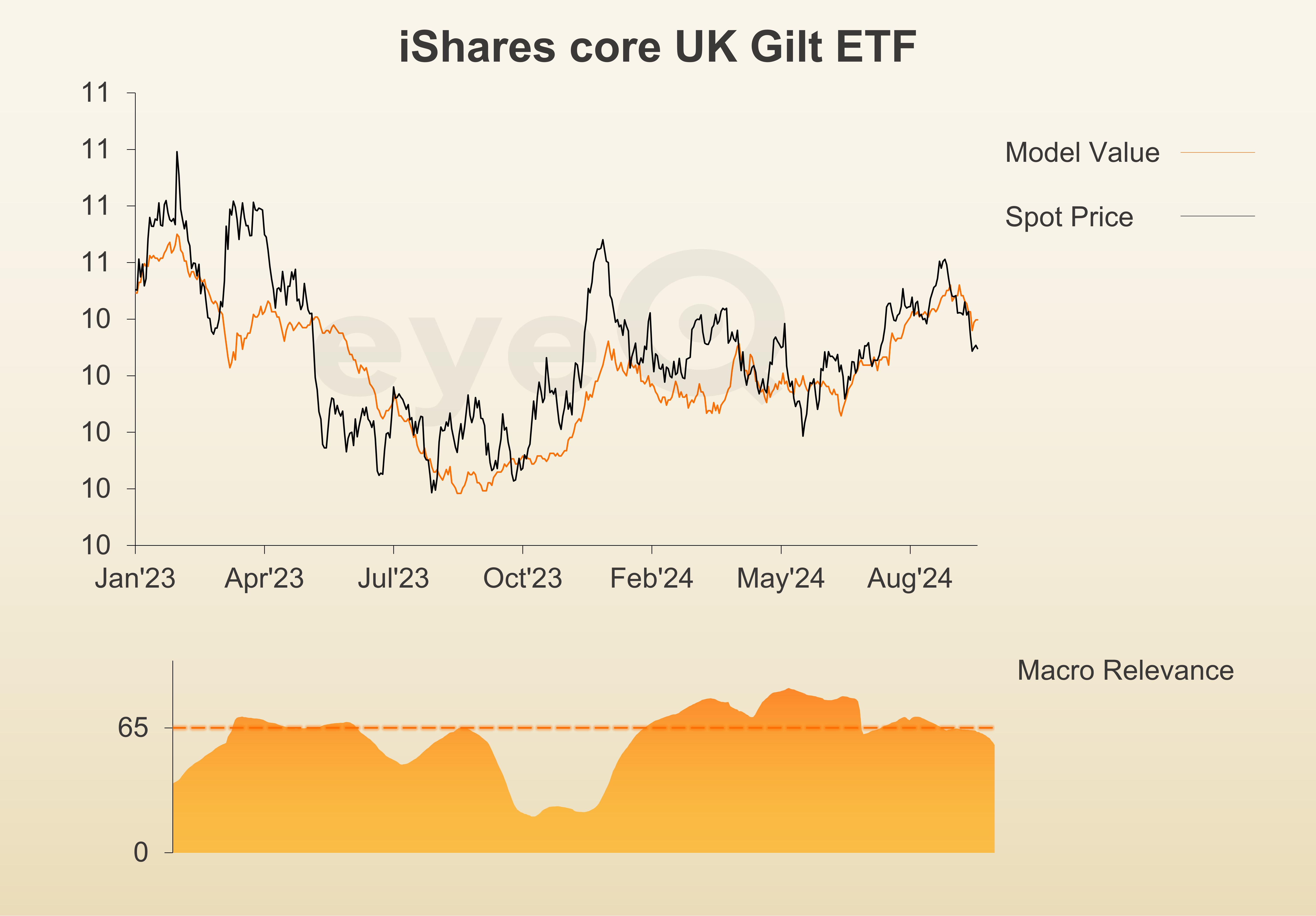eyeQ: keep powder dry for this post-Budget move
Experts at eyeQ use AI and their own smart machine to analyse macro conditions and generate actionable trading signals. It’s just highlighted a potential opportunity in the UK gilt market.
10th October 2024 11:08
by Huw Roberts from eyeQ

"Our signals are crafted through macro-valuation, trend analysis, and meticulous back-testing. This combination ensures a comprehensive evaluation of an asset's value, market conditions, and historical performance." eyeQ
- Discover: eyeQ analysis explained | eyeQ: our smart machine in action | Glossary
iShares Core UK Gilts ETF
Macro Relevance: 57%
Model Value: £10.38
Fair Value Gap: -0.93% discount to model value
Data correct as at 10 October 2024. Please click glossary for explanation of terms. Long-term strategic model.
Yesterday’s “inflation fright and policy risks” post highlighted the recent sharp rise in inflation expectations in the UK and elsewhere. This is a critical story for investors right now.
One example comes in the UK gilt market, the debt of the UK government. iShares Core UK Gilts ETF GBP Dist (LSE:IGLT) is the ETF that gives investors access to UK gilts. It saves you working out which individual gilt you should buy, and which maturity is the right bond for you. It gives you across-the-board exposure to the UK government bond market.
The chart shows IGLT enjoyed decent macro momentum over the summer. eyeQ model value trended higher from June to September. But since peaking in mid-September, model value has rolled over, i.e. macro conditions have deteriorated. The biggest factor dragging things lower on our model is inflation expectations.

Source: eyeQ. Past performance is not a guide to future performance.
Bonds hate inflation - it erodes the value of their fixed coupons in real terms. So, the crude pattern is always that bonds do well during times of deflation, but suffer when inflation is rising.
And this is borne out by our smart machine. Inflation expectations are the biggest driver of IGLT on eyeQ, accounting for nearly 30% of our model. And when we inspect what’s prompted model value to fall from its £10.51 peak to £10.38 today, we see again that its inflation that’s responsible.
The good news for opportunistic investors is that the market has taken fright and overshot. The black line (showing spot IGLT) has sold off more and now sits 0.93% cheap to the overall macro environment. That’s not a big enough Valuation Gap to generate a signal on our systems, but we are getting close.
We’re also getting closer to Chancellor Rachel Reeves’ Budget, which is the big event that will determine the next move in the gilt market. So, for now, sitting on the sidelines is the prudent thing to do. But be aware that a potential opportunity could be brewing.
Useful terminology:
Model value
Where our smart machine calculates that any stock market index, single stock or exchange-traded fund (ETF) should be priced (the fair value) given the overall macroeconomic environment.
Model (macro) relevance
How confident we are in the model value. The higher the number the better! Above 65% means the macro environment is critical, so any valuation signals carry strong weight. Below 65%, we deem that something other than macro is driving the price.
Fair Value Gap (FVG)
The difference between our model value (fair value) and where the price currently is. A positive Fair Value Gap means the security is above the model value, which we refer to as “rich”. A negative FVG means that it's cheap. The bigger the FVG, the bigger the dislocation and therefore a better entry level for trades.
Long Term model
This model looks at share prices over the last 12 months, captures the company’s relationship with growth, inflation, currency shifts, central bank policy etc and calculates our key results - model value, model relevance, Fair Value Gap.
These third-party research articles are provided by eyeQ (Quant Insight). interactive investor does not make any representation as to the completeness, accuracy or timeliness of the information provided, nor do we accept any liability for any losses, costs, liabilities or expenses that may arise directly or indirectly from your use of, or reliance on, the information (except where we have acted negligently, fraudulently or in wilful default in relation to the production or distribution of the information).
The value of your investments may go down as well as up. You may not get back all the money that you invest.
Equity research is provided for information purposes only. Neither eyeQ (Quant Insight) nor interactive investor have considered your personal circumstances, and the information provided should not be considered a personal recommendation. If you are in any doubt as to the action you should take, please consult an authorised financial adviser.
Disclosure
We use a combination of fundamental and technical analysis in forming our view as to the valuation and prospects of an investment. Where relevant we have set out those particular matters we think are important in the above article, but further detail can be found here.
Please note that our article on this investment should not be considered to be a regular publication.
Details of all recommendations issued by ii during the previous 12-month period can be found here.
ii adheres to a strict code of conduct. Contributors may hold shares or have other interests in companies included in these portfolios, which could create a conflict of interests. Contributors intending to write about any financial instruments in which they have an interest are required to disclose such interest to ii and in the article itself. ii will at all times consider whether such interest impairs the objectivity of the recommendation.
In addition, individuals involved in the production of investment articles are subject to a personal account dealing restriction, which prevents them from placing a transaction in the specified instrument(s) for a period before and for five working days after such publication. This is to avoid personal interests conflicting with the interests of the recipients of those investment articles.